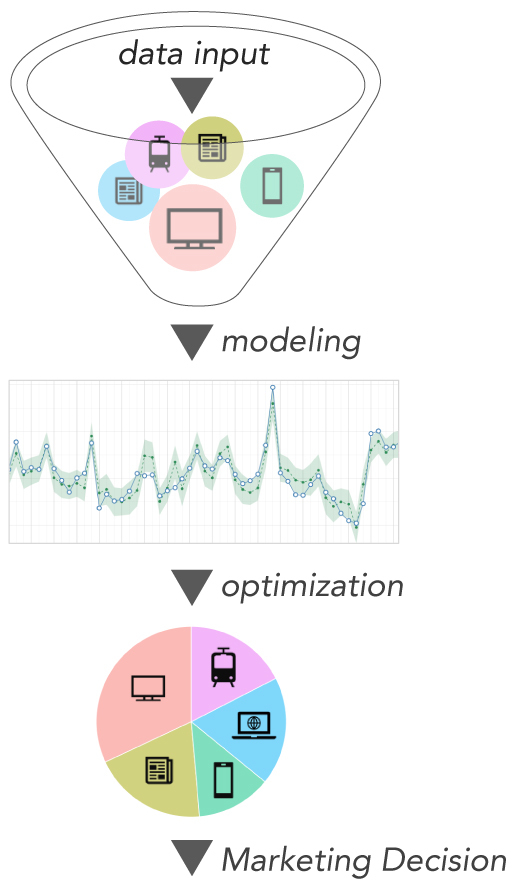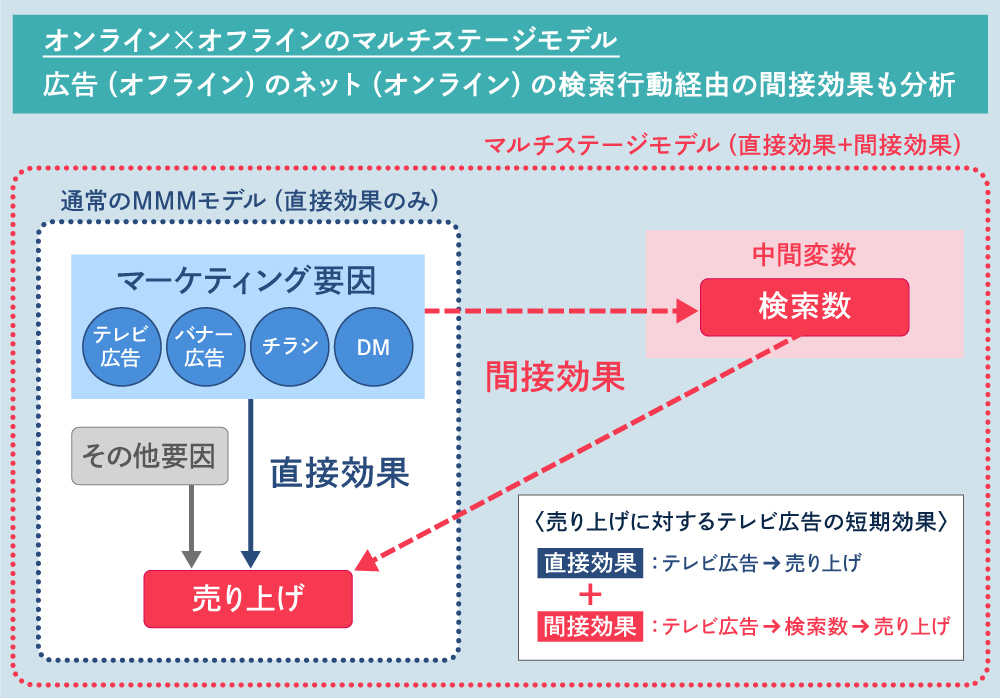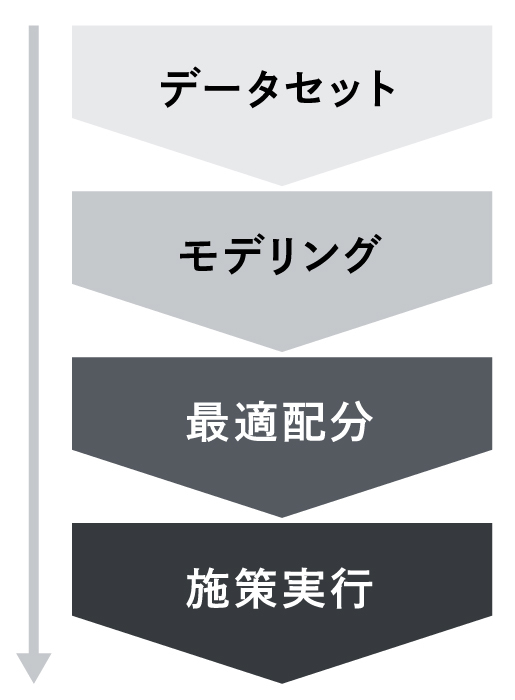Dentsu Inc.'s "Business Growth Practice Webinars" share the latest insights on the ever-evolving business landscape. This series highlights notable sessions from the Business Growth Practice Webinars 2022 by Dentsu Inc. People Driven Marketing, featuring interviews with the presenters.
This time, the theme is the increasingly prominent "MMM" (Marketing Mix Modeling). This approach uses "statistical techniques" to visualize the effectiveness of various marketing initiatives and optimize future media budget allocations.
This time, we explain a practical approach to implementing MMM based on Dentsu Group insights. We spoke with three Dentsu Group professionals: Yusuke Tanaka, a statistical expert; Hiroshi Fukuda, who approaches MMM as a marketing professional; and Tadashi Kawabe, who has extensive global MMM experience and currently serves as Representative Director at DENTSU CROSS BRAIN INC., a data utilization solutions company.
How will MMM, which uses statistical power to predict the future, transform marketing?
──For marketing professionals at companies considering MMM implementation, could you clarify the basic concepts?
Fukuda: Officially called Marketing Mix Modeling, or "MMM" for short. It's an approach that uses advanced statistical techniques based on various historical data to predict "future outcomes." As a marketer, I'll deliberately oversimplify it from a marketer's perspective: MMM is a "calculator" that determines the optimal budget allocation.
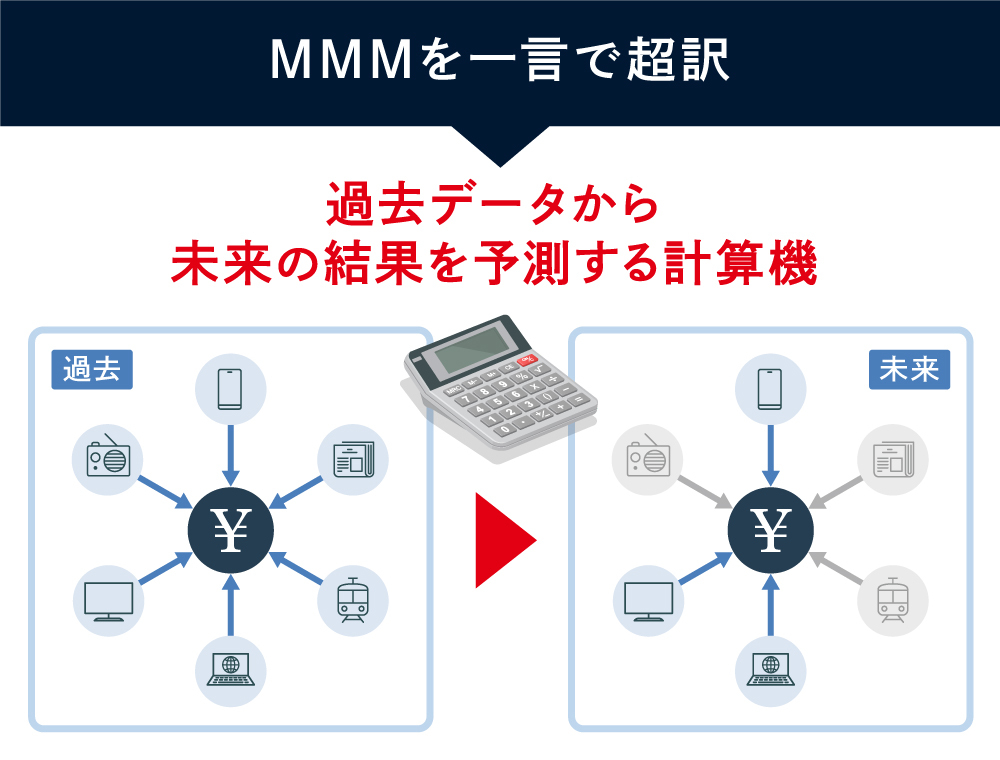
──So it's a method of predicting the future based on statistics from past data. In business, what kind of "past data" is used to make what kind of "future predictions"?
Fukuda: The goal of implementing MMM is to optimize the allocation of marketing activity budgets, including advertising spend. First, we prepare the necessary datasets by organizing time-series data such as past "marketing initiatives" and "various external factors unrelated to marketing activities." This time-series historical dataset is extremely important.
From this data, we decompose the "effects" of each initiative and external factor on the "target variable"—such as sales or conversion (CV) counts—and visualize their "contribution."
For example, this enables comparison of ROI (return on investment) per CV for the same amount spent, allowing side-by-side comparison of various initiatives across online and offline channels.
By statistically deriving this ROI, we can determine the "optimal allocation" – how much budget should be allocated to each marketing initiative to maximize the objective variable.
For instance, we can forecast the projected number of target variables (KGI) achievable next period for each budget level, facilitating discussions within internal teams on the following year's activity plans. While this is an estimate and not a guarantee, it serves as an objective benchmark. I believe this background in the marketing environment is driving the demand for MMM implementation.

──You mentioned past data includes "marketing initiatives" and "various external factors." What specific figures are used?
Fukuda: For marketing initiatives, we use data on the amounts invested in various ads like TV commercials, digital ads, OOH ads, newspaper ads, and so on. For external factors, we input indices representing specific market conditions, such as the Nikkei Stock Average, or economic trend indices, as needed. These marketing initiatives are called "explanatory variables."
For instance, during the COVID-19 pandemic period, there were MMM cases that incorporated external factor data like the trend in new COVID-19 infections. There are also cases where competitor advertising volume (GRP investment) is incorporated as an external factor for analysis. This is precisely the part that needs to be decided through discussion with the client.
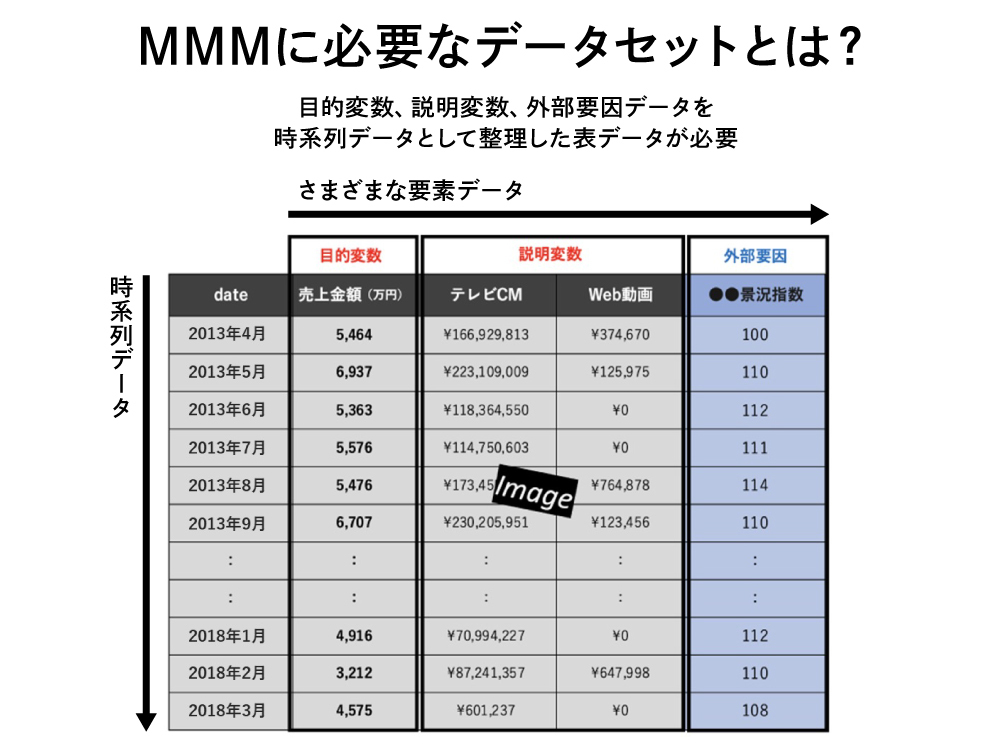
──Regarding the target variables like "sales" or "conversion counts," I imagine these vary by company. Can they be customized individually?
Fukuda: Absolutely. We set them according to the client's business, such as "number of store visitors," "sales amount," or "number of online member sign-ups." A crucial point when setting these objective variables is confirming whether they are "data that can be continuously collected over time." For example, can the data be reliably collected weekly or monthly? If the objective variable cannot be collected continuously, the effect of the explanatory variables cannot be measured either. Therefore, thorough discussion during the dataset design phase is essential.
Kawabe: The basic form of MMM is analyzing the "direct effect" – how much each marketing initiative contributes to the objective variable, "sales." However, for some clients, a marketing initiative might influence "search volume," and this "search volume" could then have a significant impact on sales.
In such cases, we set "search volume" as an intermediate variable and incorporate the contribution of marketing initiatives to this intermediate variable into the model as an "indirect effect" for evaluation.
Fukuda: To summarize, the general steps of MMM involve analyzing the prepared dataset over time using algorithms to determine the optimal budget allocation.
Why MMM? Three Reasons MMM Implementation is Essential Today
──By the way, when you say MMM, does that mean there isn't just one type, but various types?
Tanaka: That's correct. In this context, "type" refers to the computational mechanism, or "algorithm." There are truly numerous MMMs utilizing different algorithms. What they share in common is "predicting the future based on past data."
Common algorithms employ techniques like "multiple regression analysis" or "structural models." At Dentsu Inc., we've developed and offer "Fast-MMM," which utilizes a "state space model" algorithm particularly suited for analyzing time-series data.
Kawabe: Furthermore, MMM doesn't necessarily handle everything on its own; there are various marketing schemes that incorporate MMM. For example, in the US, it's common to combine a "top-down" approach—like using MMM to decide budget allocation across media like TV and digital—with a "bottom-up" approach, such as using attribution analysis for detailed budget allocation among digital ad menus.
──What's the underlying reason MMM is gaining attention in today's marketing environment?
Kawabe: There are three main factors. First, heightened awareness around personal data protection. Traditional ROI calculations relying on third-party cookies have become increasingly difficult, leading to greater interest in MMM as a replacement method that allows statistically sound analysis of marketing initiatives.
Second, there's a stronger demand for accountability in marketing initiatives. Amid uncertainties like the pandemic and rising raw material costs, allocating large budgets requires compelling, data-driven justification that resonates internally.
Third is the need for "overall optimization" of initiatives. With increasing touchpoints between companies and consumers, and a multi-channel business environment, many companies are using separate tools for each channel, essentially pursuing individual optimization. Consequently, many companies likely face challenges in achieving "overall optimization" of their marketing initiatives.
Tanaka: The second point is particularly significant. As market conditions shift dramatically, the flexibility to incorporate various "external factors" into the model is a key strength of MMM, a statistics-based approach.
──Is MMM adoption also progressing as a global trend?
Kawabe: Yes. Globally, MMM has become a standard solution. Companies are using MMM as a common benchmark, enabling various internal sections to collaborate on marketing strategies. I believe it's becoming that foundational element.
Actually, the concept of MMM itself is quite old. I've worked on MMM with many clients, primarily in the US. However, a major recent change is the "democratization of MMM," exemplified by Google releasing an open-source package called "Lightweight MMM." This has lowered the barrier for companies to implement MMM.
Tanaka: The fact that companies don't necessarily need to have dedicated scientists in-house is also a factor driving the adoption of MMM.
Before rushing to implement it, understand that MMM has its limitations.
──Nowadays, many companies are saying, "Let's implement MMM!" But there's also an impression that MMM is being viewed as some kind of "silver bullet." What's the reality?
Fukuda: It's crucial to fully grasp MMM's advantages and disadvantages. Among its strengths is flexibility—it can account for various variables, like the impact of external factors. It also serves as a compass for explaining and discussing with internal stakeholders based on objective data.
Kawabe: Furthermore, since models are built using existing historical data, there's no need to design test marketing campaigns. This means no upfront costs, which is a significant advantage.
Tanaka: For example, in a typical A/B test, you only run ads in either Area A or Area B to verify effectiveness. This approach means the area not running ads suffers an opportunity loss. In contrast, MMM uses statistical methods, which can reduce this opportunity loss.
However, as a trade-off, the level of evidence is lower compared to AB testing. Rather than debating whether MMM or AB testing is better, it's about prioritizing what matters most for the business and evaluating based on the specific case.
Kawabe: Another advantage is its high reproducibility, meaning you can obtain sufficiently "reliable answers" as simulation results for future predictions.
Fukuda: On top of high reproducibility, simulations can be run immediately with just historical data. For example, given budgets of ¥200 million, ¥250 million, or ¥300 million, we can quickly calculate the "optimal allocation" based on statistics. While the required precision varies, this speed becomes a major asset when deciding marketing strategies.
──Conversely, what are MMM's weaknesses?
Tanaka: As Fukuda mentioned, since it's a statistical approach, a certain amount of accumulated "historical data" is naturally a prerequisite. This means that even if a client requests incorporating a new initiative or new menu into MMM, we can't reflect it immediately. We inevitably need a certain period of campaign running before we have sufficient data for analysis.
Furthermore, tailoring the model to the client's needs requires time for analysis and validation. For these reasons, we often cannot fully accommodate requests like "We need the budget by next week."
And, of course, a minimum level of statistical literacy is beneficial. You need to be able to interpret the results—to determine whether they stem from the impact of the initiative or from the underlying assumptions of the statistical methodology.
Kawabe: In that sense, I believe it will also become necessary to build the environment in collaboration with external statistical professionals.

Which "type" of MMM excels at "time series analysis"?
──Moving on to a more technical topic, let's discuss the "Fast-MMM" algorithm you developed, Mr. Tanaka. I understand that general MMM is a model based on "multiple regression analysis" that also accounts for external factors like seasonal effects. Isn't Fast-MMM different from multiple regression analysis?
Tanaka: Fast-MMM is not just multiple regression; it's a hybrid MMM based on a "state space model." Its key feature is robust time series analysis capability. What this means is that multiple regression analysis fundamentally requires data where each piece of information (row) is independent.
Fukuda: I didn't fully grasp this initially either, so let me try to explain it in simpler terms. Imagine weight loss or diet activities.
Suppose you set "Weight Loss (kg)" as the target variable and analyze it using explanatory variables like daily "Calories Consumed," "Calories Burned," and "Distance Jogged (km)." In multiple regression analysis, these variables reset daily, making it difficult to analyze them as continuous diet activity data spanning today, tomorrow, and the day after. Yet, in reality, today's results continuously carry over into tomorrow, right?
This "consistency is power" dynamic is hard to capture with multiple regression analysis. I hope you can see why.

Tanaka: That's why we use a hybrid statistical method incorporating a "state space model," which can express time series data more effectively. The table at the top of the diagram—with individuals A, B, C, D, and E—shows unrelated data, so multiple regression is fine. But the bottom table shows Mr. A's continuous data. This is called "dependent data," and you simply cannot use multiple regression here.
Fukuda: As I explained earlier, MMM is computational. It helps to think of it as having rules. Here, "rules" refer to basic arithmetic rules like "division comes before addition." Ignoring the rules and doing addition first might "complete the calculation," but the result would be wrong. I see this as a similar concept.
Tanaka: This model excels at handling both time-series elements—like the periodicity of trends and seasonal factors—and the "decomposition" of campaign elements. This allows us to accurately measure the effectiveness of marketing campaigns without overestimating or underestimating their impact.
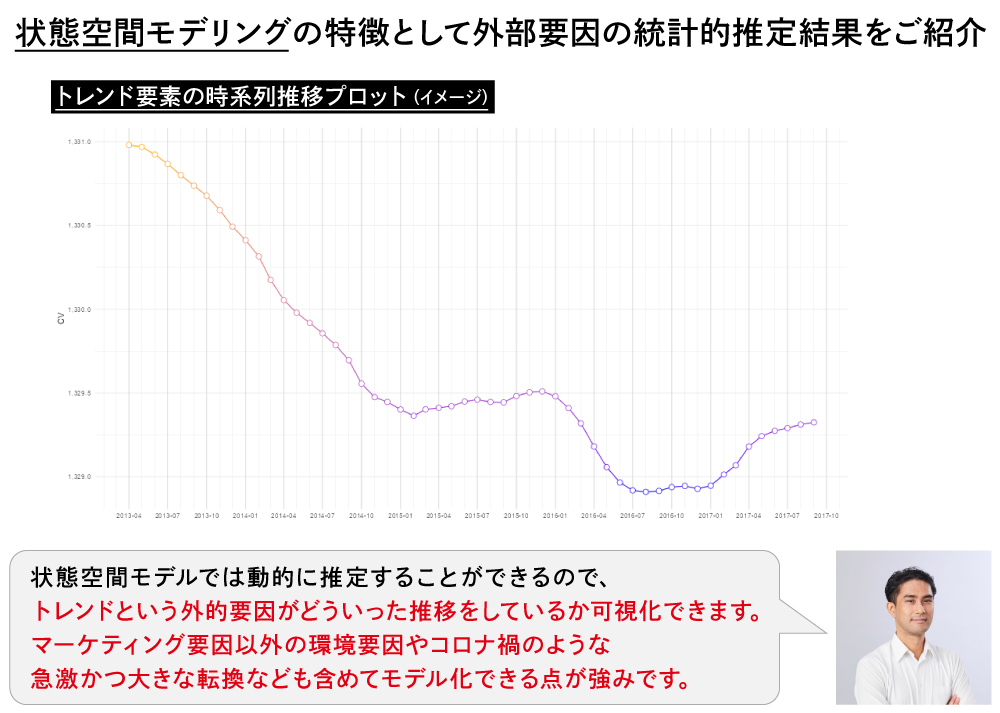
If there should only be one "optimal allocation," what's the intent behind deriving the top 40?
──Regarding the Fast-MMM you developed, it uses past data (advertising initiatives and external trend factors) as a dataset to output the budget allocation that maximizes the target variable, "conversion count," correct? Looking at the dashboard screen, instead of deriving just one optimal budget allocation, it displays the top 40. What is the intent behind this?

The bar graph shows the budget allocation per media, while the line graph shows the "expected number of conversions for that allocation." The one on the far left, sim.001, has the highest expected number of conversions and is the "optimal budget allocation." But... ?
Tanaka: This is merely "statistically, this budget allocation should offer the highest cost-effectiveness." But in actual marketing, various circumstances often prevent implementing it exactly as shown. For digital ads, you can buy impressions in units of yen, but you can't buy TV commercials in units of yen. Also, the client's "intent" – like "we absolutely want to run this campaign with this specific budget" – is crucial.
Therefore, within simulations of multiple combination patterns, we consider the practical realities of media buying and prepare several optimal combination options.
Fukuda: When humans handle marketing, each client has different media circumstances and business-judgment-based decisions. We ensure discussions can focus on finding the best allocation that fits the conditions, taking all these factors into account.
Tanaka: To derive such practical, optimal budget allocations considering these realities, Fast-MMM enables "combination exploration within the same budget." This emphasis on "practical usability" is one of Fast-MMM's major features.
──I see. So it's an MMM developed not only with advanced capabilities but also with the needs of actual marketing practitioners in mind.
Tanaka: Yes, Fast-MMM's core concept is "making cutting-edge algorithms a basic skill." We focus on whether non-scientist marketers can effectively utilize advanced algorithms in their daily work, prioritizing practical usability.
What matters is being able to generate solid campaign strategies that form the foundation for discussion.
──The true value of MMM isn't just that a computer shows you the "correct answer." It's about presenting highly reproducible simulations, then incorporating marketing "context" and "intent" to enable internal discussion.
Fukuda: Yes. We view it strictly as a tool for incorporating hypotheses, verifying them, and facilitating group discussion. It is by no means a universal tool capable of anything.
Expectations inevitably rise with MMM, but managing those expectations is truly crucial.
Kawabe: Simply running MMM doesn't directly lead to executing campaigns. After simulating budgets with MMM, the question becomes how to fine-tune them. This is where past knowledge and insights, including those from planners and creatives, become crucial. Since MMM isn't a panacea, it's best viewed as a foundation for discussions among stakeholders: "We have this data, but how should we approach the actual campaign?"

──Finally, do you have a message for companies interested in MMM? For those wanting to start MMM now, implementing something like Dentsu Inc.'s Fast-MMM is one option. However, you also mentioned that overall design is important, not just MMM alone.
Tanaka: Personally, I believe there's value simply in using MMM as a catalyst to start accumulating your company's sales and conversion volume trends alongside advertising spend data. Given that data restrictions are likely to increase going forward, I think it's crucial to expand your first-party data as much as possible. In that sense, I hope MMM can serve as a catalyst for collecting your company's spend data and key performance indicator (KPI) data like sales in a time-series format.
Kawabe: The Dentsu Group boasts diverse talent. For example, my DENTSU CROSS BRAIN INC. has data specialists with extensive global experience. We can certainly consult on MMM alone, but we can also accompany clients from the ground up to build data marketing frameworks, including MMM, tailored to their specific needs.
Fukuda: Whether you are currently considering MMM implementation or have already implemented it but are struggling with effective operation, we encourage you to consult with the Dentsu Group.



